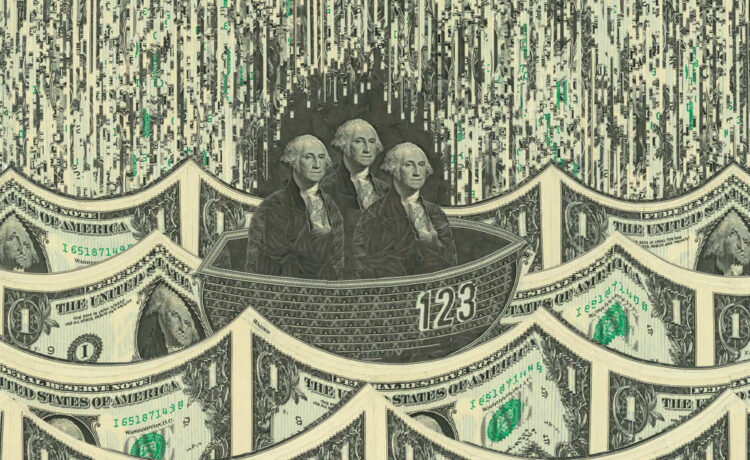About the author: Marc Chandler is chief market strategist for Bannockburn Global Forex, a division of First Financial Bank.
Could the world’s largest emerging markets launch an alternative currency to rival the dollar? Might they back it with gold? Some of the leaders of the Brics—Brazil, Russia, India, China, and South Africa—have talked up these ideas as they prepare to meet for a summit in the coming days.
There are two chances: slim and none.
The dollar’s demise is a story foretold, and therein lies the problem. Today’s arguments are only the latest iteration of a narrative that predates the end of Bretton Woods, and end of the dollar’s last link to gold 52 years ago on Aug. 15. China and India are more interested in internationalizing their currencies than in creating some new one. Russia has had to abandon any such hopes with its invasion of Ukraine. Brazil and South Africa aren’t even in the game. And contrary to popular wisdom, China isn’t particularly serious about challenging the dollar. Beijing’s two large initiatives, the Asian Infrastructure Investment Bank and the Belt Road project, make dollar loans. The AIIB takes subscriptions in dollars and appears to respect the sanctions on Russia.
Beijing talks a big game about the West’s decline. But it seems content to blame the U.S. for financial problems rather than assume the role and responsibilities of managing a global currency. Indeed, China’s swap lines with distressed countries like Argentina and Pakistan supplement the dollar, not supplant it.
Advertisement – Scroll to Continue
If China were to mount a serious challenge to the dollar, it could do three things. First, make the currency convertible. It isn’t. One cannot buy Chinese yuan at an airport kiosk like other leading and emerging market currencies. Capital flows are highly regulated. There is a market for what is called the offshore yuan, and it trades more freely. But the offshore market still most often respects the People’s Bank of China’s 2% daily limit from the officially set reference. Chinese officials have intervened in the offshore market. A convertible yuan wouldn’t need an offshore variant.
Second, China needs to create a deep and transparent central government bond market to compete with U.S. Treasuries as a global store of savings, both public and private. Most of what is thought of as China’s government debt is at the regional level. China’s on- and off-balance sheet regional debt is about 100 trillion yuan, or $14.3 trillion, when you add the Ministry of Finance’s estimate of regional bonds at 35 trillion yuan at the end of last year to the Rhodium Group’s calculation of the debt of the local government financing vehicles. The central government’s debt stood at the equivalent of about $3.7 trillion at the end of last year, which is slightly below 25% of gross domestic product.
China needs to import Alexander Hamilton’s ideas from the U.S. Recall that to help forge the nation: Hamilton proposed that the federal government “assume” the states’ debts incurred in the War of Independence. Since the war wasn’t fought equally through the new republic, not all of the states favored the nationalization of the debt. As we know, as part of the great compromise, which included making the District of Colombia the capital, the “Assumption” plan carried the day. Nationalizing China’s regional debt would create a large and deep central government bond market. That would also put the local governments on sound fiscal footing.
Advertisement – Scroll to Continue
Third, Beijing needs to make it easier and more attractive for foreign businesses and governments to issue yuan-denominated bonds. To be sure, there is an offshore yuan bond market dubbed “dim sum.” Its main users are Chinese businesses and governments. Outstanding issuance was estimated at about $350 billion at the end of the first quarter of 2023. Just a few foreign governments have issued in the dim sum market, primarily Southeast Asian countries, beginning with Singapore more than a decade ago. In contrast, the “panda” bond market of foreign yuan issuance on the mainland is meager at about $60 billion. After all, reserves are evaluated in terms of trade (imports) and foreign debt obligations (especially short term). The more foreign entities take on yuan exposure, the more central banks are incentivized to hold yuan assets in reserves.
A deeper panda bond market, in conjunction with a convertible currency and a larger and more transparent central government bond market, are the basic building blocks that Beijing needs if it is truly going to compete with the dollar. Federal Reserve economist Colin Weiss noted in a paper late last year that three-quarters of foreign government Treasury holdings are held by countries that have military ties to the U.S. China does not have comparable military relationships with other countries, but it has shown it is able to lever trade ties and investment to achieve noneconomic goals. Still, Weiss concluded, “even a reduced reliance on the U.S. dollar for trade invoicing and debt denomination by a large bloc of countries less geopolitically aligned with the U.S. would be unlikely to end U.S. dollar dominance.”
Despite Fitch’s recent decision to take away the U.S. AAA rating, as S&P did more than a decade ago, China won’t be able to capitalize outside of schadenfreude. Yet the downgrade suggests what the bigger threat to the dollar is. It isn’t encroachment, but abdication.
Guest commentaries like this one are written by authors outside the Barron’s and MarketWatch newsroom. They reflect the perspective and opinions of the authors. Submit commentary proposals and other feedback to [email protected].

